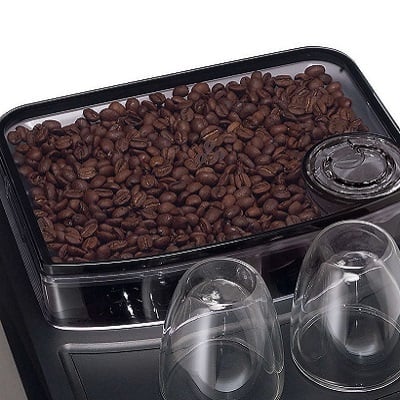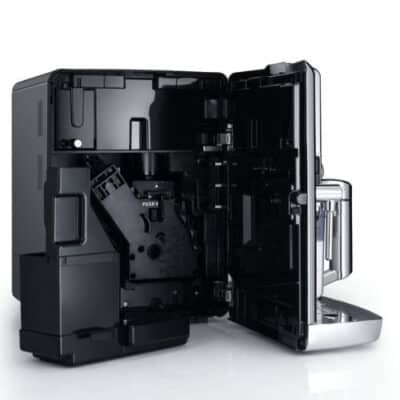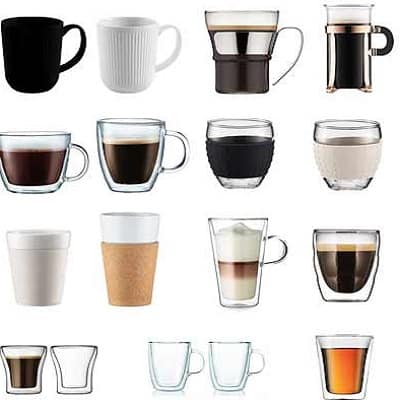Bean to Cup coffee machines are quickly becoming more and more popular, in fact more Brits now rely on them for their morning brew than ever before.
And why not, they make the otherwise cumbersome process of brewing a great espresso as simple as pressing a button.
They handle every aspect of the process from storing and grinding the beans, to the dosing and brewing method.
So considering they take a significant investment, you would expect every cup of coffee to be like it was made by world class baristas.
The natural reaction then, when your espresso doesn’t quite hit the mark is to blame your new coffee maker.
But before you get on the blower to the customer support teams, it may be worth considering the fact its not the tool but the user that is to blame.
Yes your bitter coffee could be down to you, the operator..
But fear not, 99% of the reasons are down to some very simple and easy to correct mistakes people make time and time again.
So today’s article will go over these and what you should be doing instead.
Plus I will also reveal some simple tricks and hacks that will guarantee you get the best espresso possible from your new bean to cup machine.
The 6 Most Common Coffee Machine Mistakes
So as I mentioned the majority of reasons for bad tasting coffee can be classified by one of the below 6 common mistakes…
Water Quality
By far and large the most common mistake of all, is assuming you can simply fill your brand new coffee machines water tank with tap water.
I can certainly understand why, I mean tap water is just water right?
Wrong, despite being the same in appearance, not all water is the same.
Depending on where you live, your tap water could vary greatly from soft to hard. Its all to do with your waters mineral balance.
A quick search online and you will see many an expert advise for best results you want your water to be as soft as possible, but this is not always the case. It really depends on your local water composition.
Some hard minerals such as calcium will actually help improve your coffees flavour
You can tell with certainty though, if your espresso has any sort of metallic taste, then this is an indication of to much iron and copper, and you will probably want to use a water filter.
Some coffee machines will have an recommended filters and some of the best models will even analyse your local water and advise what filter you should use, such the as Jura E6.

Coffee Beans
Bean to Cup Coffee Machines are pretty awesome, in fact I think they’re so great I dedicated a whole website to all things bean to cup. But they do not perform miracles
They are not capable of and never will be capable of turning bad coffee beans into a decent cup of coffee.
It doesn’t matter whether you use an espresso machine, a bean to cup or French press, if you want a quality coffee then you simply have to use quality beans, there is no way around this.
Coffee beans come from all over the world and have such a varying flavour profile, you can find the perfect coffee bean for you. So there really is no excuse.
So whether you fancy a South American, and African or Asian use my handy guide to find your prefect bean
Stale Coffee
Just as important as buying high quality beans is the need to keep those coffee beans in tip top condition.
You can buy the best beans in the world, but if you let those beans spoil, then you may as well have saved the money and bought some cheap supermarket coffee in the first place.
Similarly just because you have enjoyed the coffee produced from a certain coffee bean before, if you buy it when its not at its best, then the chances of recreating that great cup of joe is none existent.
So what’s the solution?
Make sure you buy beans from a good roaster, one who advises the “roasted on date” and then make sure you are using them, ideally within two months of the roasted date.
Don’t buy in bulk and them store them in a specialty container, most decent machines hopper will protect the beans.
One of the major benefits of a bean to cup machine is the fact they grind your beans fresh on demand, so the least we could do is give it fresh beans to work with. Read more on how to stale coffee here.
Your Machine Is Not Clean

This is not as obvious as most people think, I am not referring necessarily to the exterior of your coffee maker and making sure the stainless steel is sparkling.
No I am referring to properly cleaning it, removing the different parts and ensuring it is clean throughout.
I understand this is not what you dreamt of when you were first planning your new coffee machine, but you have to take this seriously.
If you don’t…
Then leftover coffee will build up and affect the flavour of your next brew, as well as bacteria and other nasties spoiling your drink.
This one of the easiest mistakes to make, I get it, its one of things you think ill do it tomorrow, but from experience tomorrow never comes. A good idea is to make a schedule and stick to it.
Or if you can’t make a schedule, then buy a coffee machine that will tell you when it needs cleaning, yes they do exist. You can even get one with an app to tell you when its time
Read my full guide on how to clean a coffee machine
Maintenance
Bean to cup machines are a significant investment and as such you should expect them to last a decent amount of time, and they will, provided…..
You look after them properly and treat them with care
Now I could have quite easily lumped this one in with the cleaning above. But it is important enough to warrant its own section. A lack of a proper maintenance schedule, will have you rooting around in the loft for that old filter coffee machine much sooner than expected.
Most manufacturers will have clear and concise maintenance instructions, I urge you to follow them. The most important part will be the descaling, this is vital to prevent the build op of limescale.
Limescale will not just affect the taste of your coffee, but will damage the machine beyond repair.
Cup

If you are as strange as me, then you will already believe that your coffee tastes better out of your favourite mug than any other cup. Even the exact same mug that just isn’t yours..
But I am not referring to coffee lovers superstition here, no I actually have a serious point to make.
Your coffee REALLY will taste better, when you drink it from the appropriate cup.
Firstly you NEVER want to drink from a cheap plastic coffee cup or even worse a polystyrene cup (you know what I mean here, think a cuppa from a dirty greasy spoon)
Ceramic or glass make the best materials for your coffee
I would recommend ceramic for a larger beverage and glass for shorter coffees such as cappuccino or espresso shots.
The Setup & Settings
Hints, Tips and Hacks
Modern bean to cup coffee machines are so customisable, they allow the user to control almost every aspect of the coffee brewing process.
Even to relatively experienced home baristas these can sometimes be a little confusing, just the sheer number of controls and options can quickly overwhelm.
But not getting to grips with your machine and its settings is one of the biggest mistakes you can make, just a small adjustment can alter the flavour of your coffee.
Pro tip : Adjust one thing at a time, that way you know exactly what effect each setting has
Grinder
Most coffee machine owners I talk to, all tell me they adjusted the grind settings when they first set up the machine, but this is not enough..
You really need to re-adjust the grind when you change your beans, and if you want to be really pedantic depending on the drink you’re making.
As a rule of thumb if you have a lightly roasted bean, then you should go for a finer grind and the darker roasts a more coarse the grind.
The science behind this is, the finer you grind the coffee beans, the longer the brew / extraction time will be.
Different flavour compounds infuse at different points, if its too quick you will have sweeter and less caffeinated shot, and too long and it will taste smoky and bitter.
So how do you know when you have the correct level?
Well a really quick way to know you have hit the sweet spot is your espresso shot will take between 25-30 seconds to pull. And the shot itself will full and thick bodied and will have a dense crema sitting on top.
But ultimately the best judge of whether your settings are correct is…
The taste, if you like it, then you’re all good.
Amount of Coffee
I am yet to come across any bean to cup coffee machine that doesn’t allow you to control the quantity of coffee grounds it uses to make your cup of joe.
While some machines allow you get real granular here, most just have pre set options, such as weak, medium or strong.
It is easy to see then, why owners think this will only affect the strength of your brew. But that is a mistake, as it also directly affects the taste of your coffee.
Much like the coarseness of your beans, described above, the amount of coffee in the filter basket will affect the brew time.
As you get more experienced you will adjust the quantity of coffee and the coarseness in conjunction with each other.
Amount of Water
Similarly the amount of water will also affect the strength of your coffee, much the same as the amount of coffee.
You really need to adjust this in conjunction with the amount of coffee in the filter basket.
Try to avoid using a small amount of water through a large amount of coffee, this will result in an extended extraction time and a more bitter coffee.
And the opposite, too much water going through a small amount of coffee will result in a weak, watery shot.
The Final Word
I know this seems really daunting, even I took a few deep breathes when I got my machine, but you really needn’t be scared of playing around.
The factory settings on your coffee machine will be good to go, but by adjusting the settings you really can achieve some quite amazing results and find the perfect coffee just for you.

